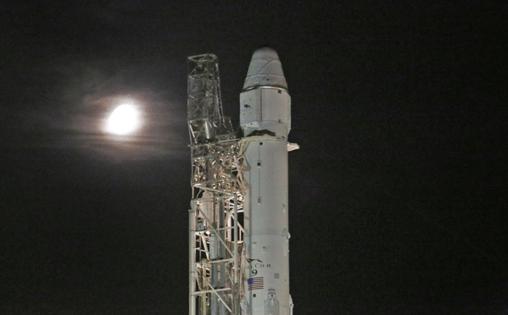ks // Full Harvest Moon to be supermoon rising ahead of SpaceX launch
Published in Science & Technology News
The first of the year’s only three supermoons will rise Monday night with the full moon coming just before midnight Eastern time and just minutes before a planned launch of a SpaceX rocket.
The near side of the moon will have 100% illumination at 11:47 p.m. when it’s about 224,000 miles from Earth, according to timeanddate.com. The combination of full moon and its proximity to the moon’s closest approach to the planet, or perigee, can make it a supermoon.
The moon’s perigee technically will be 223,580 miles away, but not until 8:37 a.m. Wednesday, according to data maintained on a site run by Fourmilab Switzerland. The moon can range in distance to Earth from about 221,000 miles to as far as about 255,000 miles.
But the moon is still close enough for the near-full moonrise Monday at 6:32 p.m. and continuing on through Tuesday night’s waning gibbous-phase moonrise to make it seem as much as 30% brighter and 14% larger.
The moonrise itself will enhance the effect of a visually larger moon because of a lensing effect of the Earth’s atmosphere.
This month’s full moon is the closest to the autumnal equinox, which occurred on Sept. 22, and is referred to as the Harvest Moon, according to the Farmer’s Almanac. The Harvest Moon can either fall in September or October depending, and as such, this year’s October full moon won’t be called the Hunter’s Moon, according to the almanac.
The next two supermoons will come in the final two months of the year with the Nov. 4-5 moonrises the best time to view the moon that technically will be full at 8:20 a.m. Nov. 5, and then Dec. 4 at 8:15 p.m.
The November full moon will be the one closest to perigee this year with the moon’s closest approach of 221,735 miles away at 5:30 p.m. Nov. 5, so that might make for the best moonrise just minutes later at 5:36 p.m., only nine hours after it reaches full moon status.
For those who hang in to midnight, they could also catch a glimpse of a SpaceX Falcon 9 launch.
The rocket is targeting liftoff during a four-hour window that runs from 12:10-4:10 a.m. on the Starlink 10-59 mission carrying 28 satellites from Cape Canaveral Space Force Station’s Space Launch Complex 40.
The first-stage booster is making its eighth flight and will aim for a recovery landing downrange on the droneship Just Read the Instructions, stationed in the Atlantic.
Space Launch Delta 45’s weather squadron forecasts at 65% chance for good launch conditions, which improves to 90% in the event of a 24-hour delay.
Orlando’s weather forecast calls for a few showers to clear up in the evening for partly cloudy skies through midnight.
SpaceX also has a Tuesday-night launch planned with another Falcon 9 on the KF-3 mission to launch 24 more satellites for Amazon’s Project Kuiper constellation lifting off from Kennedy Space Center Launch Pad 39-A during a launch window that runs from 9:46 p.m. to 12:20 a.m. Oct. 9.
This would be third of three contracted Project Kuiper flights Amazon has with SpaceX, and sixth overall flight to put operational satellites into orbit.
The other three have been from ULA Atlas V launches this year. This batch would bring Amazon’s satellite total to 153 of the planned 3,236 total needed to be in orbit by July 2029 (half of which are supposed to be in orbit by July 2026).
The first-stage booster is flying for second time and will aim for a recovery landing on the droneship Just Read the Instructions, stationed in the Atlantic.
_____
©2025 Orlando Sentinel. Visit orlandosentinel.com. Distributed by Tribune Content Agency, LLC.







Comments